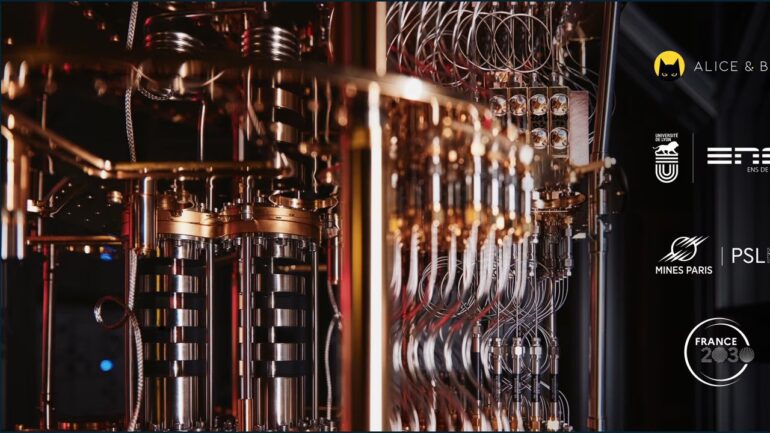- Alice & Bob, along with academic partners, received a €16.5 million innovation grant from France’s public investment bank, Bpifrance.
- The funding aims to advance quantum computing technology, particularly focusing on cat qubits and reducing costs.
- The initiative, named “Cat Factory,” targets key challenges in quantum computing, such as nanofabrication, chip design, and electronic control systems.
- Specific goals include decreasing control and readout lines per cat qubit, optimizing infrastructure, and increasing analog ports and control lines per cryostat.
- The ultimate objective is to develop a fault-tolerant quantum computer architecture by 2027, making quantum computers ten times cheaper and market-ready three years earlier.
- Alice & Bob’s approach promises substantial energy savings and decreased end-user expenses by confronting genuine quantum computing hurdles head-on.
Main AI News:
Alice & Bob, along with academic partners ENS de Lyon and Mines Paris-PSL, have secured a substantial €16.5 million innovation grant through France 2030 initiative, administered by Bpifrance, France’s public investment bank.
This funding injection marks a significant milestone in the journey of Alice & Bob, a quantum computing hardware developer with bases in Paris and Boston. The company, founded in 2020, has been steadfast in its mission to pioneer the first universal, fault-tolerant quantum computer. Having already amassed €30 million in funding, expanded its team to over 95 professionals, and showcased experimental breakthroughs that rival industry giants like Google and IBM, Alice & Bob is poised for transformative progress.
At the heart of Alice & Bob’s endeavors lies their specialization in cat qubits, a pioneering technology initially developed by the company’s founders and later embraced by Amazon. The newly funded initiative, dubbed “Cat Factory,” will see a collaborative effort between industry and government partners to address critical challenges in quantum computing across multiple technological fronts. This includes advancements in nanofabrication, chip design, validation, digital tools, and electronic control systems.
The primary objective of this collective endeavor is to expedite the development of quantum computing by streamlining the efficiency of the entire technology stack, driving down costs, and hastening market readiness. The ultimate target is to engineer a novel, optimized architecture for fault-tolerant quantum computing by 2027, with specific goals including:
- Decreasing the number of control lines per cat qubit from 4.5 to 2
- Reducing readout lines per cat qubit from 1 to 0.2
To realize such optimization benchmarks, enhancements will be made to the infrastructure of enabling technologies surrounding the Quantum Processing Unit (QPU). This involves augmenting the number of analog ports per rack from 60 to 180, thereby reducing the footprint of control electronics by a third. Furthermore, the project aims to escalate the count of control lines per cryostat from 200 to 2000, leveraging cutting-edge cabling technology.
According to Theau Peronnin, CEO of Alice & Bob, “We are honored to spearhead the drive towards making quantum computing practical at an earlier stage. Our strategic approach, centered around cat qubits, confronts the genuine hurdles of quantum computing head-on, resulting in substantial energy savings and decreased end-user expenses.“
The projected expenses associated with cryogenics and managing large sets of qubits currently present formidable barriers to widespread adoption. Utilizing the newly acquired funding, Alice & Bob intends to optimize quantum computation comprehensively, spanning from initial design to manufacturing and infrastructure development. The overarching aim is to render quantum computers tenfold cheaper to produce and market-ready three years ahead of schedule.
“Quantum computing algorithms necessitate hundreds of logical qubits, equating to thousands to millions of physical qubits,” remarked Florent Di Meglio, the project’s lead at Mines Paris—PSL. “Cat Factory endeavors to achieve 100 logical qubits utilizing only three cryostats, marking a monumental reduction in the hardware required for operating a functional quantum computer.”
To attain this ambitious objective, the collaborative partners will focus on refining the entire architecture of quantum computing systems and fortifying the accompanying infrastructure of enabling technologies. At the core of the project lies the cat qubit, which already exhibits a sixty-fold reduction in the number of physical qubits necessary to construct a logical one.
Paul-François Fournier, Executive Director of Innovation at Bpifrance, expressed his enthusiasm, stating, “We are thrilled to bolster Alice & Bob in their pursuits, aimed at expediting the advancement of quantum computing. This support underscores Bpifrance’s unwavering commitment to fostering disruptive innovation.”
Conclusion:
The substantial investment secured by Alice & Bob signifies a significant leap forward in the quantum computing landscape. Their focused efforts on optimizing key technological elements, particularly with the innovative cat qubits, hold promise for revolutionizing the industry. This injection of funding not only accelerates the development timeline but also underscores growing confidence in the potential for quantum computing to reshape various sectors, from scientific research to commercial applications. As quantum computing becomes more accessible and cost-effective, businesses across industries will need to adapt to harness its transformative power and stay competitive in the evolving market landscape.

